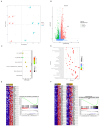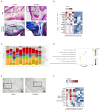Potential Role of Malassezia restricta in Pterygium Development
- PMID: 40243577
- PMCID: PMC11989039
- DOI: 10.3390/ijms26072976
Potential Role of Malassezia restricta in Pterygium Development
Abstract
Pterygium is a condition affecting the ocular surface, marked by a triangular-shaped growth of fibrotic tissue extending from the nasal conjunctiva toward the corneal center, potentially causing visual impairment. While ultraviolet (UV )light exposure is the primary risk factor for pterygium, its underlying cause remains unclear. In order to better understand the true genesis of pterygium development, we investigated pterygium tissue and compared it with healthy conjunctiva controls. Given the eye's direct environmental exposure, we analyzed the microbiota composition using metagenomic sequencing of pterygium tissue to identify microbes potentially associated with this condition. Metagenomic sequencing revealed a higher prevalence of the fungus Malassezia restricta in five pterygium samples, confirmed by in situ hybridization. The CHIT1 gene, which plays a role in antifungal defenses, displayed the highest expression in five pterygium tissue samples compared to healthy conjunctiva controls, suggesting the potential involvement of Malassezia restricta in pterygium development. Gene expression profiling of pterygium highlighted an IL-33 and IL-4 gene expression signature, along with an increased presence of M2 macrophages, emphasizing their role in promoting fibrosis-a hallmark feature of pterygium. The detection of Malassezia restricta in the pterygium samples and associated molecular changes provides novel insights into the ocular microbiome and raises the possibility of Malassezia's involvement in pterygium pathology.
Keywords: CHIT1 gene; Malassezia restricta; ocular microbiome; pterygium.
Conflict of interest statement
The authors declare no conflicts of interest.
Figures





Similar articles
-
Immunophenotypic characterization of telocyte-like cells in pterygium.Mol Vis. 2018 Dec 29;24:853-866. eCollection 2018. Mol Vis. 2018. PMID: 30713424 Free PMC article.
-
Malassezia restricta as an unexpected cause of infectious osteomyelitis diagnosed by metagenomic sequencing: a case report and literature review.BMC Infect Dis. 2024 Jun 26;24(1):643. doi: 10.1186/s12879-024-09512-9. BMC Infect Dis. 2024. PMID: 38926679 Free PMC article. Review.
-
Sociodemographic characteristics and spectrum of Malassezia species in individuals with and without seborrhoeic dermatitis/dandruff: A comparison of residents of the urban and rural populations.Med Mycol. 2021 Mar 4;59(3):259-265. doi: 10.1093/mmy/myaa050. Med Mycol. 2021. PMID: 32556200
-
Expression analysis of human pterygium shows a predominance of conjunctival and limbal markers and genes associated with cell migration.Mol Vis. 2009 Nov 20;15:2421-34. Mol Vis. 2009. PMID: 19956562 Free PMC article.
-
[Recent advances in research on Malassezia microbiota in humans].Med Mycol J. 2013;54(1):39-44. doi: 10.3314/mmj.54.39. Med Mycol J. 2013. PMID: 23470953 Review. Japanese.
Cited by
-
The Potential Role of Vitamin D in the Pterygium Pathophysiology-A Possible New Therapeutic Perspective and Narrative Review.J Clin Med. 2025 May 22;14(11):3640. doi: 10.3390/jcm14113640. J Clin Med. 2025. PMID: 40507396 Free PMC article. Review.
References
MeSH terms
Grants and funding
LinkOut - more resources
Full Text Sources
Miscellaneous

